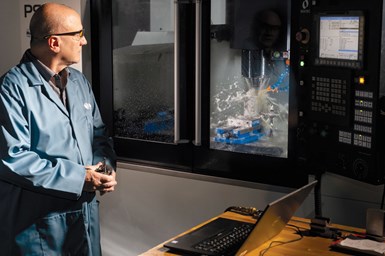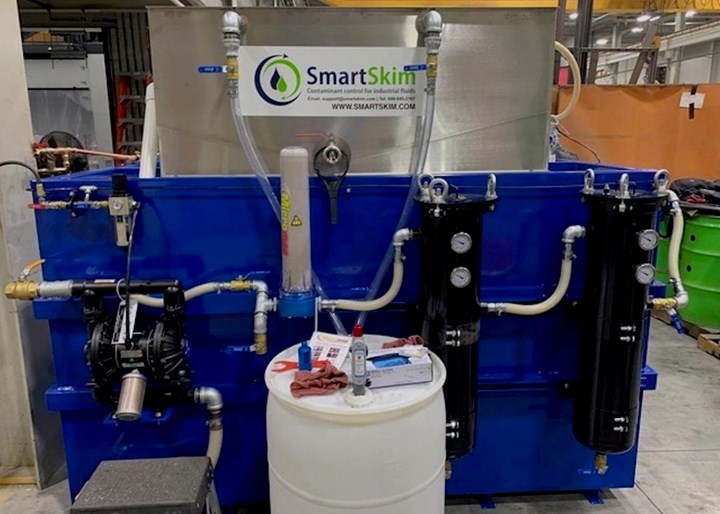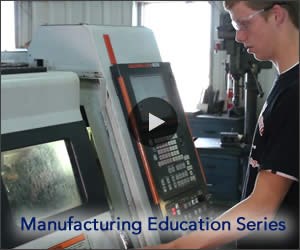
Automating cutting fluid management can free shopfloor employees from what would otherwise be labor-intensive maintenance tasks. (Photo credits: Master Fluid Solutions)
When it comes to manufacturing automation, most people immediately think of robots or perhaps complex artificial intelligence systems. While it’s true the industry is becoming increasingly technology driven, business owners don’t need to completely overhaul their operations to keep up. Leaders can implement automation on a process-by-process basis, including cutting fluid management.
Keeping cutting fluid free of tramp oil, bacteria and other contaminants is a proven way to extend both coolant and tool life, reduce operating costs and even improve a machine shop’s environment. However, it can also be labor intensive and require dedication, which makes cutting fluid management a good candidate for new equipment investments.
Cutting fluid management can transform an operation and automation can amplify its benefits. Automation removes many manual touchpoints of cutting fluid management so tasks are performed more efficiently and consistently.
One example is sensors in the machine sump that can detect concentration, reducing the need for manual fluid checks. Filling systems can also automatically add more coolant to the mix without oversight. Equipment can automatically handle almost every aspect of sump cleanouts and fluid recycling as well.
More streamlined maintenance processes translate to less machine downtime, too. Because many systems can manage cutting fluid quality on an ongoing basis, there’s less need for actual shutdowns and cleanouts. When a full shutdown is necessary, fluid management equipment can handle maintenance processes faster and more effectively than manual effort, so operations face less disruption.
Shopfloor employees can better use their time on other revenue-generating activities rather than rigorous maintenance processes.
In addition, higher machine uptime translates to higher overall productivity for an operation since throughput remains steady. Shopfloor employees can then use their time on other revenue-generating activities, rather than rigorous maintenance processes. Not only are existing production orders completed faster, but shops also have added bandwidth to take on additional jobs.
Investing in Cutting Fluid Management
Even though cutting fluid management equipment and automation can be easier to implement than other forms of manufacturing automation solutions, it’s important to take the transformation slowly, going step by step. Here’s a suggested framework to follow:
- Start with fluid management basics. The first tools a machine shop should invest in for streamlined cutting fluid management is an automatic refractometer and a solution to mix coolant, such as a proportioner. These two devices are required to maintain proper concentration in the sump, which is the basis for all cutting fluid management practices. Implementing these two solutions can help significantly cut operating costs when it comes to fluid spending.
- Prioritize cleaning systems. After purchasing basic equipment, the next phase of investment is equipment that actually cleans cutting fluid. Tramp oil removal systems such as skimming belts and coalescers can collect tramp oil from the sump on an ongoing basis and help prevent bacterial growth without extra effort. Coolant cleaning systems are an important step to extending fluid life, reducing costs even more.
- Invest more as needed. When an operation reaches higher levels of metalworking fluid spend each year, it makes more sense from an ROI perspective to invest in more advanced fluid management equipment. At this point, consider automated fill systems to improve efficiency as well as fluid recycling systems that eliminate virtually all contaminants from coolant for maximum performance and minimized waste. Extending coolant life and reducing waste costs will accelerate ROI and set your company up for even more future investments.

This coolant recycling system uses advanced coalescing and filtration technologies to assist in the removal of tramp oils, solids and bacteria in the coolant.
Manufacturing automation is the future of the machining industry, but it’s important for shop managers to take care of foundational investments so their operation remains on stable ground. Just as proper cutting fluid management is the basis of a cost-effective machine shop, cutting fluid management equipment and automation should be the basis of a future-proof machining business.
About the Author
Justin Geach is global director of marketing for Master Fluid Solutions.
Related Content
Starting Small with Automation
Quick-change workholding and flexible robotic automation started this small shop on the path to success.
Read MoreAutomation Idea for Halloween?
Maybe not. But, the candy-throwing robots at MetalQuest’s Nebraska facility do enable the contract machine shop to stand out at career fairs and similar events.
Read MoreHigh-Volume Machine Shop Automates Secondary Ops
An Ohio contract shop added a compact, self-loading CNC lathe to perform unattended secondary ops on a part for a key customer rather than running it on a manually loaded chucker.
Read MoreUnattended Production Takes More Than the Most Capable CNC Machine
Process planning and reliable peripherals are key to successful lights-out manufacturing.
Read MoreRead Next
A Tooling Workshop Worth a Visit
Marubeni Citizen-Cincom’s tooling and accessory workshop offers a chance to learn more about ancillary devices that can boost machining efficiency and capability.
Read MoreApproach PMTS 2025 With a ‘Process’ Mindset
High-volume machining operations are more apt to think about the entire process of producing parts beyond the machine tools themselves. All such technology is presented at the 2025 edition of the Precision Machining Technology Show.
Read MoreThe Lost Art of Mastery
There is value to honing and mastering a craft. But it takes time and experience.
Read More











.jpg;maxWidth=300;quality=90)










